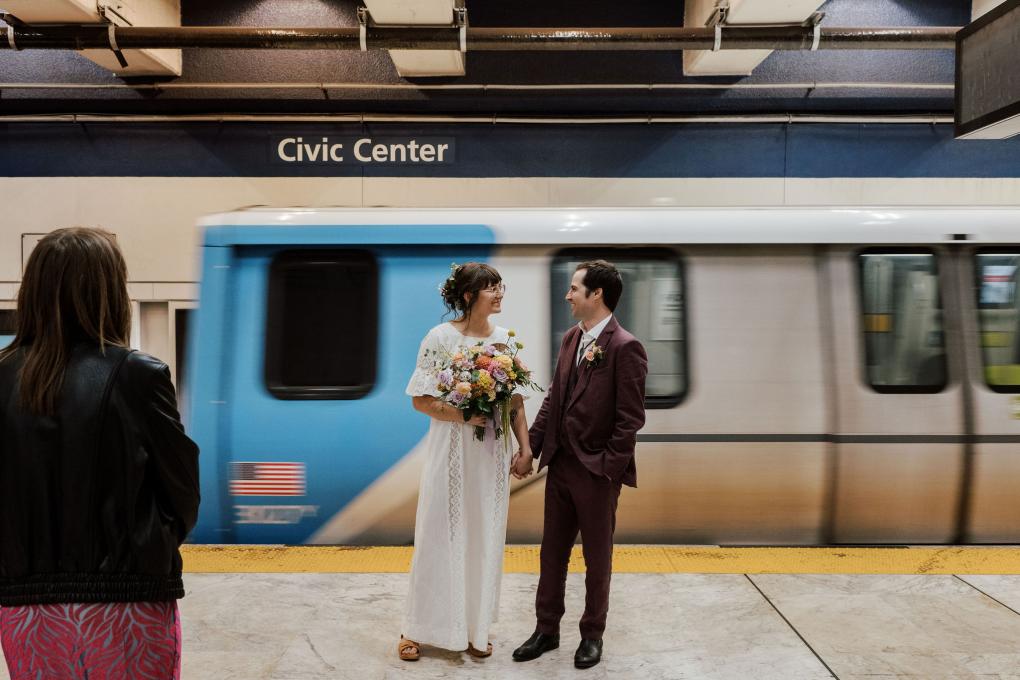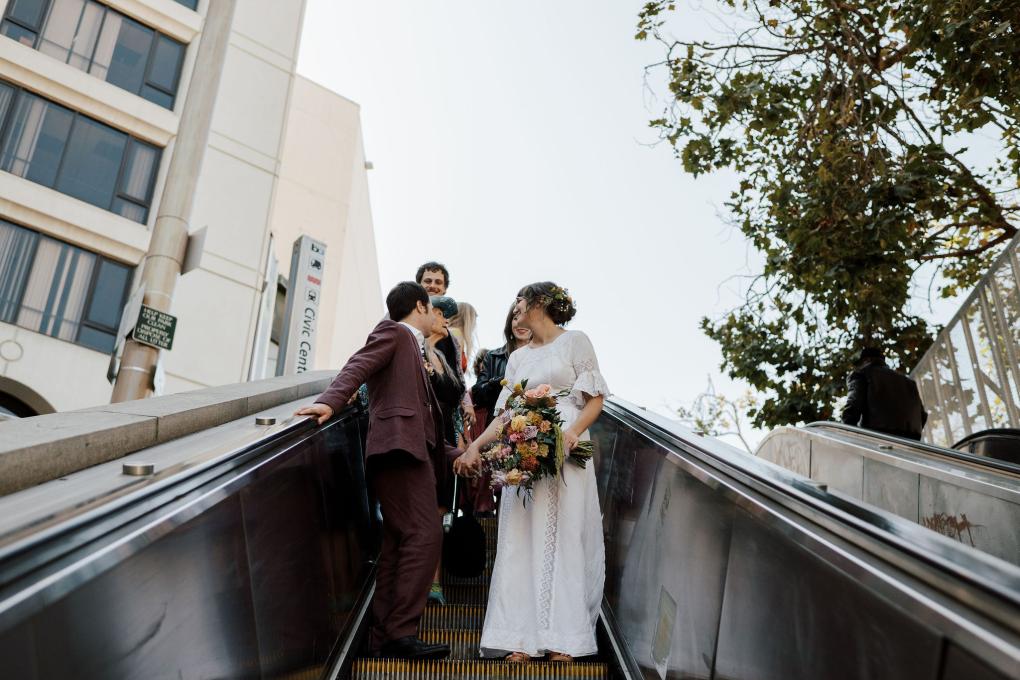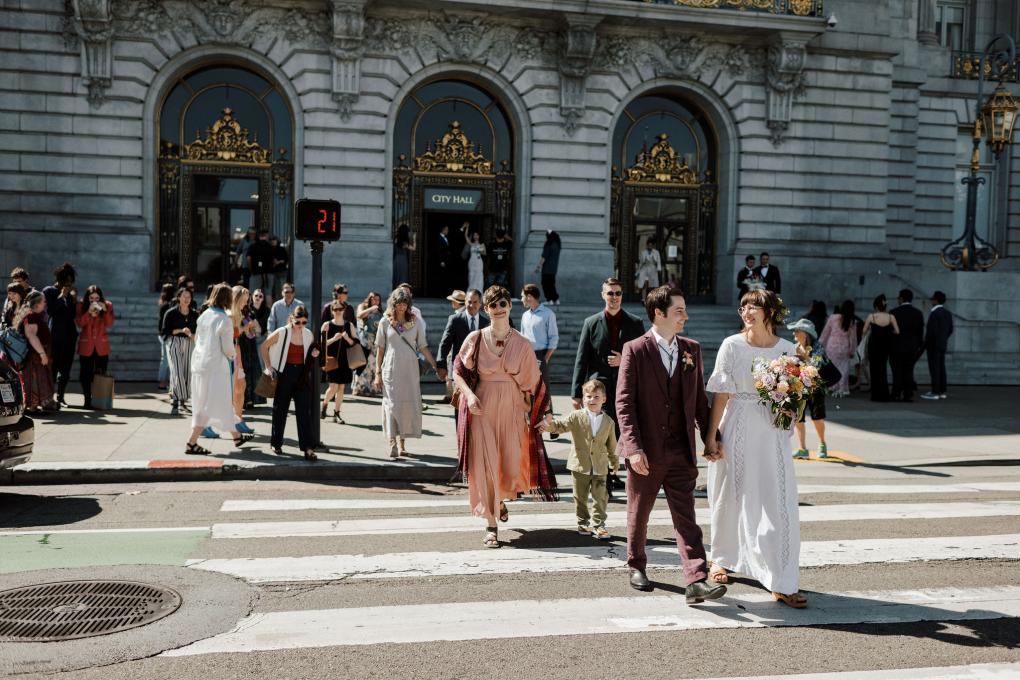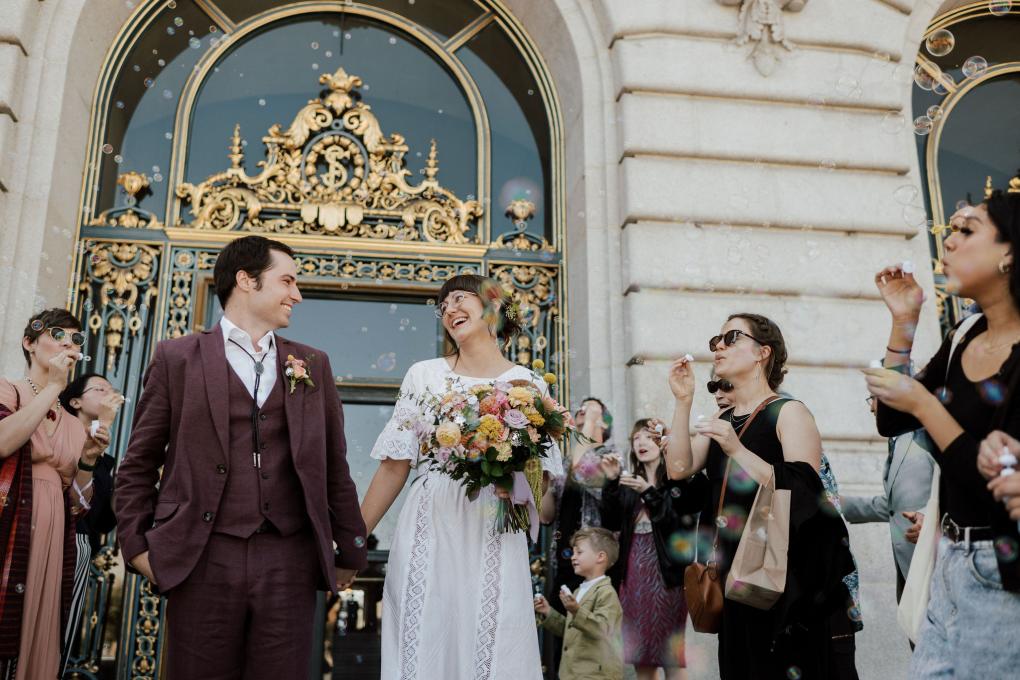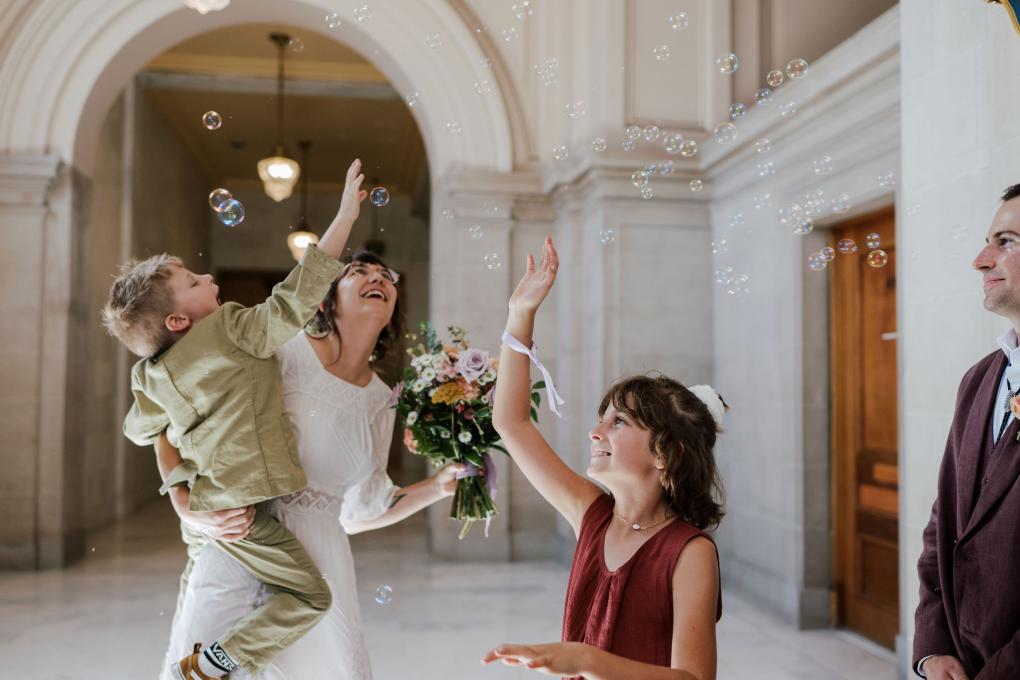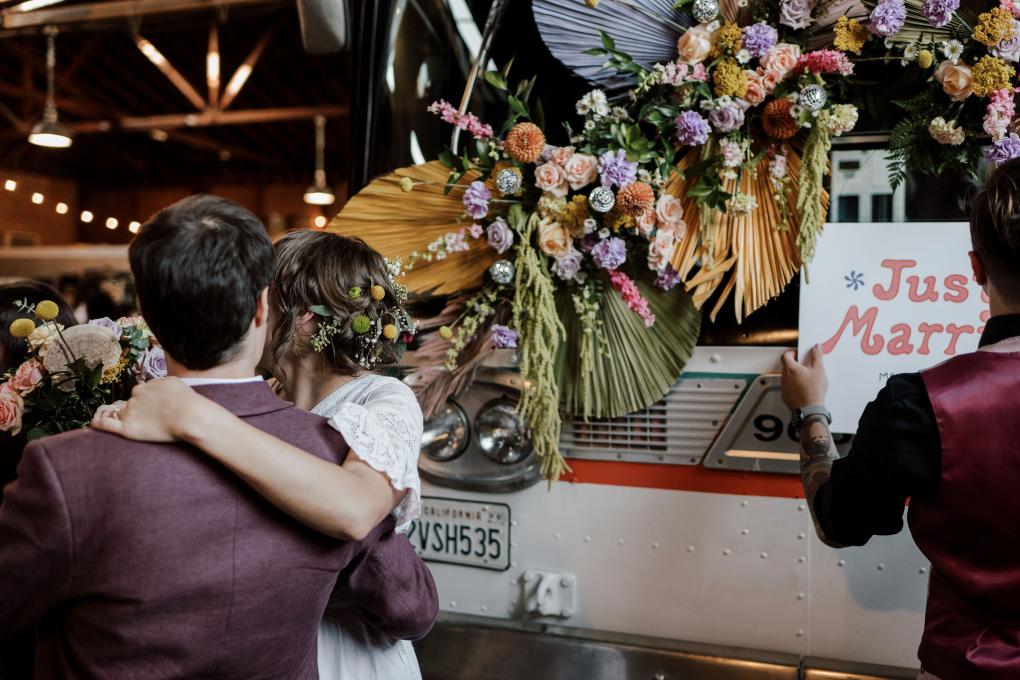BART Connects: A transit wedding happened naturally for these newlyweds
Photos courtesy of Anya McInroy Photography.
Do you have a favorite BART memory or story to share? Email a short summary to BART Storyteller Michelle Robertson at [email protected], and she may follow up to schedule an interview.
Mahalia LeClerc and Benjamin Frisbey never set out to have a transit wedding. It just kind of happened that way.
“We were never like, let’s make sure we include BART in the wedding,” said Mahalia. But when she and her now-husband picked the ceremony spot – San Francisco City Hall – and then the party venue – transit-themed Line 51 Brewing Company in Jack London Square – they needed a way to get themselves and their guests from the one place to the other. Public transit simply made sense.
“We value public transit,” Mahalia said. "And though we didn’t plan it that way, our experiences using it naturally led us to having a transit wedding.”
Mahalia and Ben set out from their hotel in Jack London Square for the ceremony on the morning of September 28. It was an unseasonably sunny Thursday, one day before the full moon. They were running late and frazzled (understandably), so at the last minute, they decided to take a rideshare to Civic Center -- “cut that out of the story,” Ben joked. But for their guests, the couple provided directions to the venue that “deprioritized cars and emphasized using public transit.” Some of their family even rode Capitol Corridor down from Sacramento, where the couple now lives, for the occasion.
When Mahalia and Ben arrived at City Hall that morning, they queued with dozens of other soon-to-be-wed couples. Mahalia said it was like a “DMV line of brides”; there were brides outside, brides on the stairs, brides in pantsuits, brides in gowns and veils and gloves. All kinds of brides. And they were all jockeying for the best photo spots.
Mahalia and Ben were lucky to snag the most coveted ceremony spot – under the rotunda at the top of the stairs, where the light from the windows casts a golden hue across the marble and stone of the enchanting Beaux-Arts building. An added surprise: The presiding judge waived the five-guest limit and invited all of the couple’s guests waiting outside to gather under the dome for the short ceremony. A friend blowing bubbles lent the scene an extra dash of whimsy.
After posing for photos, the newlyweds and their guests set out for Civic Center BART station (about a three-minute walk from city hall). They traipsed through the plaza pathway framed with knobby sycamore trees and hopped on the nearest escalator. On the concourse, Mahalia and Ben taught their guests how to get Clipper cards, and then they descended to the platform to catch a train for Embarcadero.
The station proved a ripe setting for photos. The images were not your run-of-the-mill wedding portraits. They showed Mahalia and Ben on the escalator, walking through the fare gates, on the platform as a train whooshed by. The photographer, Anya McInroy, is Bay Area born and bred. She said the opportunity to snap photos of the newlyweds around BART was “all an Oakland kid could ever dream of!”
“I have taken many images on BART over the decades, but this was my first wedding on BART, and hopefully not my last,” she said.
On the train, Mahalia and Ben said fellow passengers hardly batted an eye at them, despite the bride’s distinct white dress and the groom's suit (with a bolo in place of a bowtie).
“We got some looks for sure,” Mahalia said. “It was part of the fun.”
When they were coming up the escalator at Embarcadero Station, a street photographer brushed past, snapped a photo, and complimented their outfits before continuing on his way. People on the street and in their cars hooted, hollered, and honked. A woman in the crosswalk leading to the Ferry Building told the couple she was married just the week before.
The SF Bay Ferry that carried them to Jack London Square zipped across the churning bay. The sky was blue and cloudless. Had the wedding taken place a day later, the party on the deck would have been drenched by a rainstorm. "We kept joking that we got to take a yacht to our reception,” Ben said.
After the 35-minute ferry ride, the couple had some downtime at their hotel. From their room, they could see the boats coming in and out of the port. Then, it was time to party. Line 51 Brewery is named after the line the owner used to ride. The venue houses a real AC Transit bus from the 70s, which served as the backdrop for many a photo. Friends affixed flowers and a “Just Married” sign to its front windows.
Reflecting on the day some months later, Ben and Mahalia said the whole thing “felt very us.” All the transit riding led to some of their guests remarking, “You’re so adventurous and brave for doing that!”
“It didn’t feel out there to us,” Ben said.
Months earlier, the couple had booked Stern Grove for their wedding, but once they started digging into the planning of it, they got cold feet.
“It became a really big thing really fast,” Ben said. “So we canceled it and went back to the drawing board.” That winter, a tree fell on the Stern Grove Clubhouse. Luck, it turned out, was on their side all the way through.
During their interview with BART Communications (the interviewer herself took BART to and from her San Francisco City Hall wedding two years earlier), Ben and Mahalia began realizing how the unintentional transit theme actually made a lot of sense for their wedding.
The couple met as students at San Francisco State 12 years earlier. Before moving to Sacramento, they used public transportation as much as possible, taking Muni when they lived in the Outer Sunset District and BART when they lived near Ashby Station.
“We were so close to the line in Berkeley, you could actually see the trains go by from our window,” Mahalia said.
Ben commuted to his office in San Francisco with BART, and he said they often took the train into the city for dinner and nights out.
When the couple moved to Sacramento in 2021 for work, they quickly realized how much they missed BART and “great public transit that is so easy to use.”
“The frequency the trains come, the timed transfers, it’s all really great,” Mahalia said.
As she spoke, Mahalia began flashing back to her youth. She grew up in largely rural towns around Northern California, including Redding and Nevada City, and “couldn’t wait to get out.”
“In high school when I learned how to drive, I really didn’t like it,” she said. “I told people I was going to move to San Francisco for college so I wouldn’t have to use a car anymore.”
Ben grew up in Santa Cruz and rode his bike pretty much everywhere until he went off to college. He only took BART a few times, for class field trips and once, an Oakland A’s game with his grandpa.
“I didn’t have much public transit experience,” he said. “And then when I moved to the city, it became ingrained in my life.”
“We live in cities because we like to interact with people,” Mahalia added. “When you’re in a car, you don’t have those interactions. You might pass the same person every day and not even notice it. Transit fits into our values. You start to notice the same people on the train, and in noticing, you care more about the strangers in your community.”
About the BART Connects Storytelling Series
The BART Connects storytelling series was launched in 2023 to showcase the real people who ride and rely on BART and illustrate the manifold ways the system affects their lives. You can follow the ongoing series at bart.gov/news.
The series grew out of BART's Role in the Region Study, which demonstrates BART’s importance to the Bay Area’s mobility, cultural diversity, environmental and economic sustainability. We conducted a call for stories to hear from our riders and understand what BART means to them. The call was publicized on our website, social media, email blasts, and flyering at stations. More than 300 riders responded, and a selection of respondents who opted-in were interviewed for the BART Connects series.
